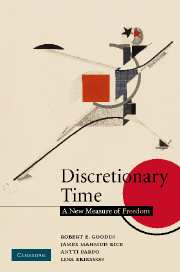Book contents
- Frontmatter
- Contents
- List of figures
- List of tables
- Preface
- Part I Introduction
- Part II Time pressure
- Part III Welfare regimes matter
- Part IV Gender regimes matter
- 10 How gender regimes differ
- 11 A temporal perspective on gender regimes
- 12 Gender regimes and temporal autonomy
- Part V Household regimes matter
- Part IV Conclusions
- Appendix 1 Methodology
- Appendix 2 Data
- Bibliography
- Index
11 - A temporal perspective on gender regimes
Published online by Cambridge University Press: 28 October 2009
- Frontmatter
- Contents
- List of figures
- List of tables
- Preface
- Part I Introduction
- Part II Time pressure
- Part III Welfare regimes matter
- Part IV Gender regimes matter
- 10 How gender regimes differ
- 11 A temporal perspective on gender regimes
- 12 Gender regimes and temporal autonomy
- Part V Household regimes matter
- Part IV Conclusions
- Appendix 1 Methodology
- Appendix 2 Data
- Bibliography
- Index
Summary
In this chapter, we will analyse the impact of gender regimes on discretionary time in the same way we analysed the impact of welfare regimes in chapter 8.
The basic measure of impact, here as there, will be the difference that is made to people's discretionary time by the state's tax, transfer and child-care subsidy policies. That is far from all that the state does, as we have said in section 8.2, and our apologies for that narrow focus must be redoubled in the case of gender regimes. Still, that is all our data allow us to assess. It is a very partial account of the impact of these gender regimes, but it does nonetheless represent an important part of what these gender regimes do.
In this chapter, we will continue to group the countries the same way as in our discussion of welfare regimes – and indeed we will continue labelling them with the same names. There is no clear, consensual alternative nomenclature emerging from the gender-regime literature surveyed in the previous chapter. Sometimes the same basic groups are distinguished, under different (and often distinctly unhelpful) names. Other times, the distinction seems to be ‘social democrats’ (sometimes under the label ‘dual-earners’) versus ‘others’. Still other times, the distinction seems to be ‘corporatists’ (under the label ‘male breadwinner’) versus ‘others’. By organizing our discussion around the three basic welfare-regime types, we retain the option of collapsing categories either of those latter two ways, according to taste.
- Type
- Chapter
- Information
- Discretionary TimeA New Measure of Freedom, pp. 177 - 191Publisher: Cambridge University PressPrint publication year: 2008



